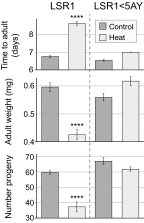Experimental replacement of an obligate insect symbiont
- PMID: 25561531
- PMCID: PMC4343100
- DOI: 10.1073/pnas.1420037112
Experimental replacement of an obligate insect symbiont
Abstract
Symbiosis, the close association of unrelated organisms, has been pivotal in biological diversification. In the obligate symbioses found in many insect hosts, organisms that were once independent are permanently and intimately associated, resulting in expanded ecological capabilities. The primary model for this kind of symbiosis is the association between the bacterium Buchnera and the pea aphid (Acyrthosiphon pisum). A longstanding obstacle to efforts to illuminate genetic changes underlying obligate symbioses has been the inability to experimentally disrupt and reconstitute symbiont-host partnerships. Our experiments show that Buchnera can be experimentally transferred between aphid matrilines and, furthermore, that Buchnera replacement has a massive effect on host fitness. Using a recipient pea aphid matriline containing Buchnera that are heat sensitive because of an allele eliminating the heat shock response of a small chaperone, we reduced native Buchnera through heat exposure and introduced a genetically distinct Buchnera from another matriline, achieving complete replacement and stable inheritance. This transfer disrupted 100 million years (∼ 1 billion generations) of continuous maternal transmission of Buchnera in its host aphids. Furthermore, aphids with the Buchnera replacement enjoyed a dramatic increase in heat tolerance, directly demonstrating a strong effect of symbiont genotype on host ecology.
Keywords: Buchnera; aphid; maternal transmission; symbiosis; thermal tolerance.
Conflict of interest statement
The authors declare no conflict of interest.
Figures



Comment in
-
Interchangeable allies: exploiting development and selection to swap symbionts.Proc Natl Acad Sci U S A. 2015 Feb 17;112(7):1923-4. doi: 10.1073/pnas.1424099112. Epub 2015 Feb 9. Proc Natl Acad Sci U S A. 2015. PMID: 25675514 Free PMC article. No abstract available.
Similar articles
-
A dual-genome microarray for the pea aphid, Acyrthosiphon pisum, and its obligate bacterial symbiont, Buchnera aphidicola.BMC Genomics. 2006 Mar 14;7:50. doi: 10.1186/1471-2164-7-50. BMC Genomics. 2006. PMID: 16536873 Free PMC article.
-
Aphid thermal tolerance is governed by a point mutation in bacterial symbionts.PLoS Biol. 2007 May;5(5):e96. doi: 10.1371/journal.pbio.0050096. PLoS Biol. 2007. PMID: 17425405 Free PMC article.
-
Impact of Facultative Bacteria on the Metabolic Function of an Obligate Insect-Bacterial Symbiosis.mBio. 2020 Jul 14;11(4):e00402-20. doi: 10.1128/mBio.00402-20. mBio. 2020. PMID: 32665268 Free PMC article.
-
Genomic revelations of a mutualism: the pea aphid and its obligate bacterial symbiont.Cell Mol Life Sci. 2011 Apr;68(8):1297-309. doi: 10.1007/s00018-011-0645-2. Epub 2011 Mar 10. Cell Mol Life Sci. 2011. PMID: 21390549 Free PMC article. Review.
-
Systemic analysis of the symbiotic function of Buchnera aphidicola, the primary endosymbiont of the pea aphid Acyrthosiphon pisum.C R Biol. 2009 Nov;332(11):1034-49. doi: 10.1016/j.crvi.2009.09.007. Epub 2009 Oct 14. C R Biol. 2009. PMID: 19909925 Review.
Cited by
-
Diplogastrellus nematodes are sexually transmitted mutualists that alter the bacterial and fungal communities of their beetle host.Proc Natl Acad Sci U S A. 2018 Oct 16;115(42):10696-10701. doi: 10.1073/pnas.1809606115. Epub 2018 Oct 1. Proc Natl Acad Sci U S A. 2018. PMID: 30275294 Free PMC article.
-
Match and mismatch between dietary switches and microbial partners in plant sap-feeding insects.Proc Biol Sci. 2019 May 15;286(1902):20190065. doi: 10.1098/rspb.2019.0065. Proc Biol Sci. 2019. PMID: 31088273 Free PMC article.
-
Gene loss and symbiont switching during adaptation to the deep sea in a globally distributed symbiosis.ISME J. 2023 Mar;17(3):453-466. doi: 10.1038/s41396-022-01355-z. Epub 2023 Jan 13. ISME J. 2023. PMID: 36639537 Free PMC article.
-
Insect Microbial Symbionts: Ecology, Interactions, and Biological Significance.Microorganisms. 2023 Oct 30;11(11):2665. doi: 10.3390/microorganisms11112665. Microorganisms. 2023. PMID: 38004678 Free PMC article. Review.
-
Host-specific co-evolution likely driven by diet in Buchnera aphidicola.BMC Genomics. 2024 Feb 8;25(1):153. doi: 10.1186/s12864-024-10045-3. BMC Genomics. 2024. PMID: 38326788 Free PMC article.
References
-
- Archibald J. One Plus One Equals One: Symbiosis and the Evolution of Complex Life. Oxford University Press; Oxford: 2014.
-
- Moran NA, McCutcheon JP, Nakabachi A. Genomics and evolution of heritable bacterial symbionts. Annu Rev Genet. 2008;42:165–190. - PubMed
-
- Shigenobu S, Watanabe H, Hattori M, Sakaki Y, Ishikawa H. Genome sequence of the endocellular bacterial symbiont of aphids Buchnera sp. APS. Nature. 2000;407(6800):81–86. - PubMed
Publication types
MeSH terms
LinkOut - more resources
Full Text Sources
Other Literature Sources

